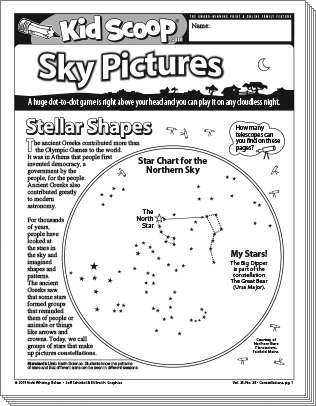 For thousands of years, mankind gazed at the night sky with fewer distractions. There was no artificial light from bulbs or street lamps to interfere with their perfectly splendid view of the heavens. These early stargazers were enchanted with the patterns traversing the evening sky as they peered upward. Ancient Greeks thought the star groups formed shapes that looked like people, animals or things like scales, hooks and dragons—and named them accordingly. These “constellations”—or groups of stars that create an imaginary shape in the night sky—became an important part of their culture, and the Greeks created stories that represent their beliefs, events, myths, experiences or morals. If you look at tonight’s sky, you will see that stars still form these patterns, and you can “connect the heavenly dots” just like children did thousands of years ago! Bring your sky map outside and see how many you can find and name—and make up a story of your own! Happy stargazing!
For thousands of years, mankind gazed at the night sky with fewer distractions. There was no artificial light from bulbs or street lamps to interfere with their perfectly splendid view of the heavens. These early stargazers were enchanted with the patterns traversing the evening sky as they peered upward. Ancient Greeks thought the star groups formed shapes that looked like people, animals or things like scales, hooks and dragons—and named them accordingly. These “constellations”—or groups of stars that create an imaginary shape in the night sky—became an important part of their culture, and the Greeks created stories that represent their beliefs, events, myths, experiences or morals. If you look at tonight’s sky, you will see that stars still form these patterns, and you can “connect the heavenly dots” just like children did thousands of years ago! Bring your sky map outside and see how many you can find and name—and make up a story of your own! Happy stargazing!
In this issue young astronomers will:
- Read expository text about stars and constellations
- Learn about astronomy and how constellations were identified by ancient Greeks
- Learn the names of famous constellations
- Recognize constellations in the night sky
- Read the legend of Ursa Major and Ursa Minor
- Use the newspaper to gather pictures for a starry art project
- Connect star dots to draw Pegasus
- Spell a constellation name using letters in the news
- Write a poem about gravity
- Use a magic decoder ring to discover the title of a fun anytime reading book
6 page PDF
